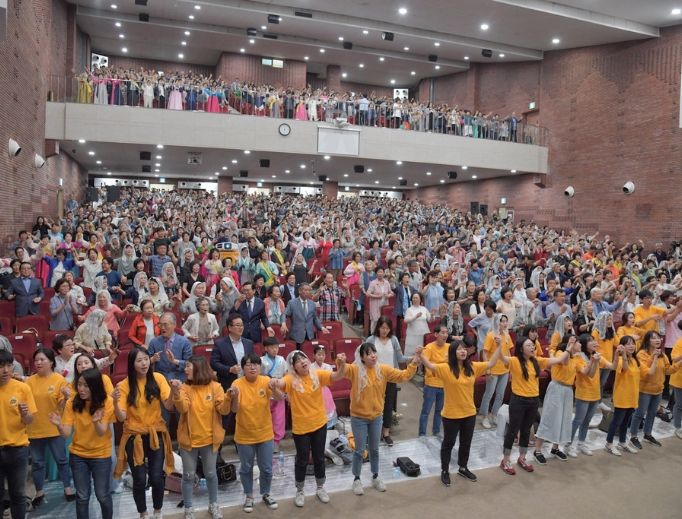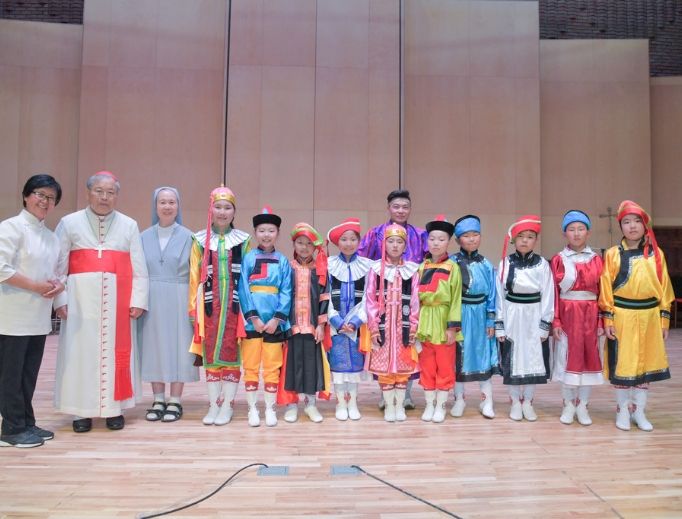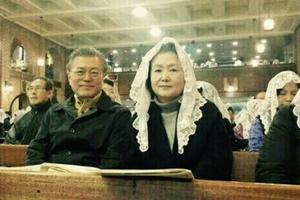Church in Korea’s Pivotal Role in Trump-Kim Meeting Could Lead to Papal Visit
NEWS ANALYSIS: The historic June 30 meeting between President Donald Trump and Chairman Kim Jong-Un on North Korean soil was less startling to one community on the peninsula: local Catholics.

Just five days before the impromptu Donald Trump-Kim Jong Un reunion at the 38th parallel, some 20,000 Catholics gathered for Mass sponsored by the Catholic Bishops’ Conference of Korea in a park near the location where the three leaders — Trump and Kim together with South Korean President Moon Jae-in — met on June 30.
The faithful marked June 25, 1950, the date when the North Korean People’s Army, backed by the Soviet Union, surged into the Republic of South Korea and kicked off a war that ended three years later with an armistice, but no formal peace agreement.
After three Moon-Kim peace summits and Trump’s newfound respect for their achievements, some Church leaders are quietly talking about an imminent papal visit to the North.
‘Ut Unum Sint’
On June 22, more than 3,000 Catholics packed a high-school auditorium to pray the Rosary, celebrate Mass and enjoy music performed by youngsters from the minuscule Catholic Church in neighboring Mongolia, a program sponsored by the Archdiocese of Seoul’s National Reconciliation Committee.


The prayer rally’s theme was Ut Unum Sint, Christ’s final words on the cross, when he beseeched God on behalf of his disciples “that they may be one” (John 17:21).
Cardinal Andrew Yeom Soo-Jung, the archbishop of Seoul and apostolic administrator of Pyongyang, the capital city of North Korea, offered a prophetic homily.
He noted a disappointing lack of progress toward unity and denuclearization on the peninsula, despite high expectations inspired by three Moon-Kim peace summits last year.
What stalled momentum was an abruptly curtailed February meeting between Trump and Kim in Hanoi, Vietnam. Positive signs were abundant until that point; the North Korean regime even proposed peaceful reunification allowing two political systems to coexist. The Hanoi rupture demonstrates how easily this effort can be derailed, said a South Korean insider without permission to speak on the record.
The dialogue option has been stifled for decades, Maryknoll Father Lawrence Murphy, an early interlocutor with Pyongyang, told the Register.
Our Lady of Fatima
So the cardinal exhorted the faithful to link their hearts with the 57 parishes and 52,000 Catholics who lived in the North before war cut the nation in half. He asked his flock to spiritually unite with the persecuted Church, sharing his conviction that “it is, to some extent, thanks to their suffering that the Church in the South has made remarkable growth so far.”
The Church in South Korea has grown faster than anywhere else in East Asia. Today, the faithful comprise some 5.6 million people, or 11% of the population.
Through this invisible solidarity, the prelate explained, North and South will achieve a spiritual unity that will bring about the physical reality of reconciliation. The Holy Father recommended this strategy when he visited Korea in 2014, in fact.
Cardinal Yeom reminded parishioners: The power of prayer can be seen in world history. The Church responded to Our Lady of Fatima by continually offering the Rosary and other prayers for the sake of the conversion of Russia, which resulted in the 1989 collapse of communism, with very little violence.
Finally, Cardinal Yeom shared with his flock moving stories of how people and nations must exercise the Christian values of forgiveness and reconciliation without waiting for political leadership to take the lead because “forgiveness must be of a Christian DNA.”
He recounted that in 1965 the Polish bishops sent to their German counterparts a pastoral letter that read: “We forgive and ask for forgiveness,” reflecting Polish suffering under the Nazi regime, while taking responsibility for their own inevitable offenses. Eventually, God, “the Lord of history,” brought renewed fraternity between Germans and Poles.
He told the story of Archbishop Stanislav Hočevar of Belgrade, Serbia. The prelate’s father was killed by a communist, yet every night, Archbishop Hočevar’s mother prayed for her husband’s killer, modeling the requirements of faith to her son.
“To forgive and reconcile each other is the necessary condition for us to be forgiven by God,” said the cardinal. “As long as we pray constantly with immense trust in God … we are sure to be able to win over the forces of evil and accomplish the miracle of peace.”
‘Something Miraculous’
One Korean who believes in miracles is at the heart of the nation’s creative, prayerful search for permanent peace: President Moon, a dedicated Catholic.
While in the U.S. last fall to meet with President Trump at the White House, Moon gave a talk in New York before an influential group of foreign-policy experts. An official of the Asia Society credited him with being the “principled dynamic” most responsible for advances made in 2017-18.
In response, the president explained, “Something miraculous is taking place on the Korean Peninsula.”
What he has done, step by step, is to build trust with the North Korean leadership through concrete initiatives — essentially implementing a “culture of encounter,” a term used often by Pope Francis. It is a vision of diplomacy premised on building personal relationships, which is particularly in sync with Asian cultural norms.
The apex of Korean diplomacy came last September, when Moon spent three days in Pyongyang, meeting for the third time with Kim and North Korean officials. He even addressed 150,000 citizens at an annual gymnastics festival. (They gave him a standing ovation.) A Catholic bishop was a member of the presidential entourage.
Moon brought home a tangible document: The Pyongyang Joint Declaration commits North Korea to permanently shut down nuclear facilities and make the peninsula free of nuclear weapons. It also commits to shutting down the main missile test site. Kim promised to visit South Korea “soon.” That was last September.
Restarting cross-border railroads and opening family-reunification centers are key nonmilitary commitments.
Evidence that the two men established personal rapport could be seen in a series of gifts the two exchanged. Kim sent Moon crates of pine mushrooms and two North Korean hunting dogs. The female gave birth to six “peace puppies,” seen on the presidential Twitter feed.
In thanks, Moon sent tons of South Korean tangerines via military planes to the northern neighbor. These are all examples of concrete steps that result in humanizing former enemies and making reconciliation natural and more authentic.
From St. Peter’s Altar
On a nine-day trip last fall to European capitals to generate support for peace — and commitments to ease sanctions on Pyongyang — Moon and his wife stopped in Rome, where he met Pope Francis and participated in a Mass offered by Cardinal Pietro Parolin, the Vatican’s secretary of state, in St. Peter’s Basilica.
At the Vatican, Moon conveyed Kim’s intention to welcome the Holy Father in the Hermit Kingdom. Francis said he would happily respond to an official invitation.
Following the “Mass for Peace,” the president gave a short talk, telling his fellow faithful that he is “certain” peace will be achieved: “Our prayers today will surely become a reality.”
Thomas Han Hong-soon, former South Korean ambassador to the Holy See, told the Register that both Church and state on the peninsula are following the same strategy to achieve three related goals: denuclearization, reconciliation and true peace.
“Dialogue, dialogue, dialogue,” he said. “That has been the key in Korea.”
“Pope Francis’ encouragement to try to resolve every problem not by domination but through dialogue — this has inspired all of us,” the diplomat added. It was a particular theme of the Pope’s 2014 visit.
Han pointed to a popular weekly devotion as evidence that lay faithful are active participants in what he termed Korea’s “prayer campaign for peace.” Every Tuesday evening at 7pm, Catholics converge on Seoul’s Cathedral of Myeong-dong to unite hearts, pray the Rosary, and participate in a Mass dedicated to reconciliation.
He said the Church talks about “true peace” on the Korean Peninsula, which requires reconciliation “with each other and God.”
The diplomat continued: “Any meeting [between international leaders] must not be a political game but an instrument through which we achieve peace and denuclearization. We pray for the right direction.”
So does Pope Francis: He did so at the Angelus June 30 immediately after the Trump-Kim meeting, as well as three months ago, when he sent a video message to the Korean leaders reminding Kim and Moon, “Through patient and persistent efforts, the pursuit of harmony and concord can overcome division and confrontation.”
Register senior correspondent Victor Gaetan is an award-winning international
correspondent and a contributor to Foreign Affairs magazine and The American Spectator.
- Keywords:
- church in korea
- korean peninsula
- victor gaetan

















